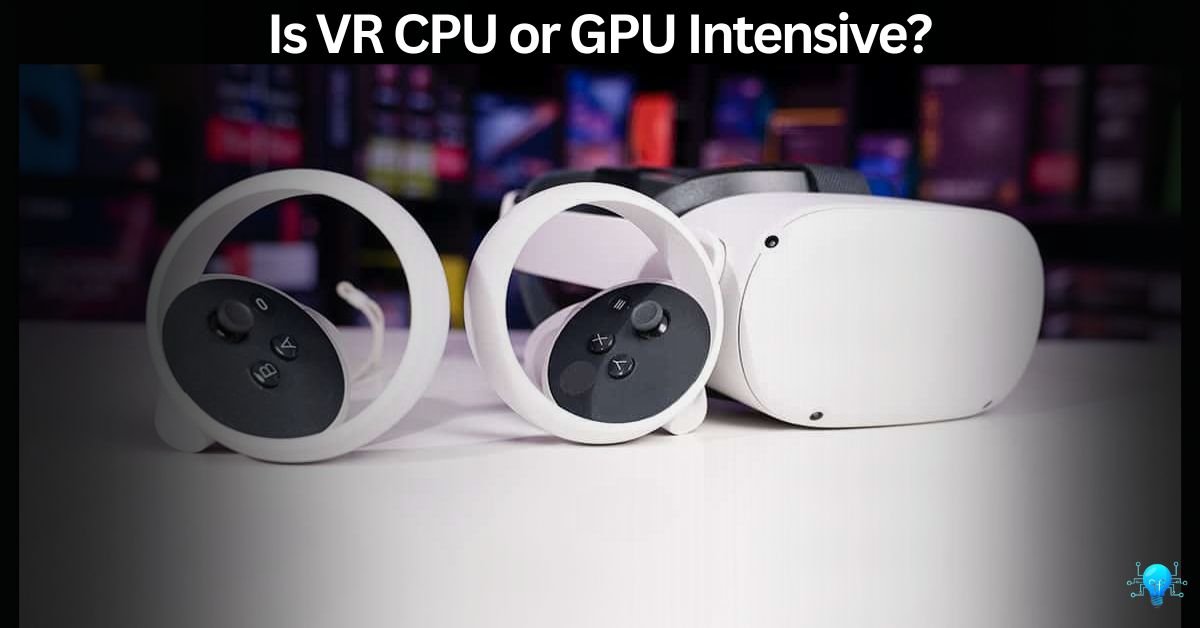Virtual Reality (VR) technology has revolutionized the way we interact with digital environments. One of the common questions among VR enthusiasts and developers is whether VR is more CPU or GPU intensive.
VR is more GPU intensive. The GPU handles rendering high-resolution graphics, essential for a smooth experience, while the CPU manages game logic and other processes.
Understanding the hardware demands of VR systems is crucial for optimizing performance and ensuring a smooth and immersive experience. So, Let’s get into it!
Understanding the Basics of VR Technology:
What is Virtual Reality (VR)?
Virtual Reality (VR) is a simulated experience that can be similar to or completely different from the real world. VR typically involves the use of headsets, controllers, and other equipment to create an immersive experience where users can interact with a 3D environment.
Components of a VR System
A VR system generally includes the following components:
- Headset: The primary device worn on the head that displays the virtual environment.
- Controllers: Handheld devices used to interact with the VR environment.
- Sensors: Devices that track the position and movements of the headset and controllers.
- Computer or Console: The hardware that powers the VR experience, which includes a CPU and a GPU.

CPU vs. GPU Intensive – What’s the Difference?
Role of CPU in VR
The CPU (Central Processing Unit) is responsible for general computing tasks and the overall management of the system. In VR, the CPU handles tasks such as game logic, physics calculations, and input processing. The CPU ensures that the VR environment reacts appropriately to user actions and maintains the game’s overall functionality.
Role of GPU in VR
The GPU (Graphics Processing Unit) is dedicated to rendering images, animations, and video. In VR, the GPU is crucial for creating detailed and high-resolution visuals, ensuring smooth frame rates, and reducing latency. The GPU’s performance directly impacts the quality of the visual experience in VR.
How CPUs and GPUs Work Together
CPUs and GPUs work together to deliver a seamless VR experience. While the CPU manages the game’s logic and interactions, the GPU handles the heavy lifting of rendering the virtual world. A well-balanced VR system ensures that both the CPU and GPU operate efficiently without bottlenecks.
Latest Post: Do You Plug HDMI into GPU or Motherboard? – See What Works!
Is VR More CPU or GPU Intensive? – Clearing It Now!
VR is more GPU-intensive than CPU-intensive according to my experiece.
While both components are crucial, the GPU handles the demanding task of rendering high-resolution, immersive graphics, which is critical for a smooth VR experience.
The CPU, on the other hand, manages game logic and other processes but generally has a lighter load compared to the GPU in VR applications.
Factors Affecting CPU Usage in VR
CPU usage in VR can be influenced by several factors:
- Game Complexity: More complex games with intricate physics and AI require more CPU power.
- Multitasking: Running additional applications or background processes can increase CPU load.
- Optimization: Poorly optimized games may rely more heavily on the CPU.
Factors Affecting GPU Usage in VR
GPU usage in VR is affected by:
- Graphics Quality: Higher resolution and more detailed graphics demand more GPU power.
- Frame Rate: Higher frame rates (e.g., 90Hz or 120Hz) require more GPU resources.
- Visual Effects: Advanced visual effects such as shadows, reflections, and particle effects increase GPU load.
Case Studies of VR Applications and Games
Examining specific VR applications and games can provide insight into their CPU and GPU demands. For instance, high-end VR games like Half-Life: Alyx are GPU intensive due to their detailed graphics and high frame rate requirements. In contrast, simpler VR applications might lean more on the CPU for processing interactions and physics.
Do You Know? Is Zotac A Good GPU Brand – An In-Depth Look!
Optimizing VR Performance – We All Want This To Do, Right?
1. Balancing CPU and GPU Loads
The first thing you need To optimize VR performance is to balance the loads on the CPU and GPU.
And, This can be achieved by adjusting settings such as resolution, texture quality, and frame rate to ensure neither the CPU nor the GPU becomes a bottleneck.
2. Ugrading Hardware for a Better VR Experience
Nextly, Upgrading to a more powerful CPU or GPU can significantly enhance the VR experience. For example, moving from a mid-range GPU to a high-end model can improve visual quality and frame rates, while a faster CPU can handle more complex game logic and physics.
3. Software Tweaks to Improve VR Performance
Software optimizations can also improve VR performance. This includes updating drivers, optimizing game settings, and using performance-enhancing software tools. Ensuring that the operating system and VR applications are running the latest versions can help mitigate performance issues.
Read Also: Can I Use Radeon Gpu With Intel Cpu – Yes, You Can But!!!
Popular VR Games and Their Hardware Requirements
Hgh-End VR Games
High-end VR games like Half-Life: Alyx and No Man’s Sky VR demand powerful GPUs for high-resolution textures and smooth frame rates. These games typically require GPUs like the NVIDIA RTX 3080 or AMD Radeon RX 6800 XT.
Mid-Range VR Games
Mid-range VR games such as Beat Saber and Superhot VR can run smoothly on less powerful hardware, such as the NVIDIA GTX 1660 or AMD RX 580. These games balance visual quality and performance, making them accessible to more users.
Entry-Level VR Games
Entry-level VR games, including Job Simulator and Keep Talking and Nobody Explodes, are designed to run on modest hardware. GPUs like the NVIDIA GTX 1050 Ti or AMD RX 560 can handle these games effectively.
Give It A Click: PNY GPUs Review – Are They Worth The Hype?
Comparing VR Headsets – CPU and GPU Demands!
Oculus Rift
The Oculus Rift requires a mid to high-end GPU and a competent CPU to provide a smooth VR experience. The recommended specifications include an NVIDIA GTX 1060 or AMD Radeon RX 480 GPU and an Intel i5-4590 or AMD Ryzen 5 1500X CPU.
HTC Vive
The HTC Vive has similar hardware requirements to the Oculus Rift. It demands a robust GPU and a capable CPU, such as the NVIDIA GTX 1060 or AMD Radeon RX 480 and an Intel i5-4590 or AMD FX 8350.
PlayStation VR
PlayStation VR is designed to work with the PlayStation 4 and PlayStation 5 consoles. The performance of PlayStation VR is primarily dependent on the console’s hardware, which integrates both CPU and GPU functionalities.
Valve Index
The Valve Index is one of the most demanding VR headsets in terms of hardware requirements. It recommends an NVIDIA GTX 1070 or AMD RX Vega 56 GPU and an Intel i5-7500 or AMD Ryzen 5 1600 CPU for optimal performance.
Have You Checked: Does Evga Make Good Gpu
Common VR Performance Issues and Solutions:
Lag and Stuttering
Lag and stuttering can significantly disrupt the VR experience. To mitigate these issues, ensure your hardware meets the recommended specifications and close unnecessary background applications.
Graphics Glitches
Graphics glitches, such as tearing or artifacting, can often be resolved by updating GPU drivers and ensuring that the VR headset firmware is up to date.
Heat Management
VR systems can generate considerable heat, which may affect performance. Ensure your PC or console has adequate cooling and consider using external cooling solutions if necessary.
Must Read: eGPU Dock – Affordable For Everyone!
Future of VR – Trends in CPU and GPU Development!
Advances in CPU Technology
Future advancements in CPU technology, such as increased core counts and higher clock speeds, will enhance the processing capabilities of VR systems, allowing for more complex and interactive environments.
Some Expected Chnages in GPU Technology
Continued improvements in GPU technology, including better ray tracing and higher memory bandwidth, will drive the visual quality of VR experiences, making them more realistic and immersive.
Emerging VR Technologies
Also, Emerging VR technologies, such as wireless headsets and foveated rendering, will further enhance the VR experience by reducing latency and improving visual fidelity.
Our First Piece Of Blog: Is Valorant CPU or GPU Intensive? – Strong GPU Needed!
Some Related Queries You May Have:
Can I Run VR with an Older CPU/GPU?
Running VR with an older CPU or GPU is possible, but the experience may be suboptimal. It’s recommended to meet at least the minimum hardware requirements specified by the VR headset manufacturer.
How Important Is RAM for VR?
RAM is crucial for VR as it affects the system’s ability to handle multiple processes simultaneously. A minimum of 8GB is recommended, with 16GB or more being ideal for a smoother experience.
What Are the Minimum Requirements for VR?
Minimum requirements for VR typically include a mid-range GPU (e.g., NVIDIA GTX 1050 Ti), a quad-core CPU (e.g., Intel i5-4590), 8GB of RAM, and a USB 3.0 port. However, for the best experience, higher-end hardware is recommended.
Can integrated GPUs handle VR?
Integrated GPUs typically lack the power needed for a smooth VR experience. Dedicated GPUs are recommended for rendering high-quality VR graphics and maintaining optimal performance.
Do VR systems benefit from overclocking?
Yes, overclocking the GPU and CPU can enhance VR performance by increasing processing speed and rendering capabilities. However, it should be done cautiously to avoid overheating and ensure system stability.
How does resolution impact VR performance?
Higher resolutions provide better visual clarity in VR but demand more from the GPU. Balancing resolution with frame rate is crucial to maintain a smooth and immersive experience.
Is VRAM important for VR?
Yes, VRAM (Video RAM) is important for VR as it stores textures and other graphical data. More VRAM allows for higher resolution textures and better overall graphics quality in VR environments.
Can VR cause motion sickness?
Yes, VR can cause motion sickness in some users, especially if there is lag or low frame rates. Ensuring high frame rates and reducing latency can help mitigate motion sickness.
To Sum Up:
So, Now we know that Virtual Reality (VR) is generally more GPU intensive than CPU intensive. This is because VR applications require high-resolution graphics and smooth frame rates to provide an immersive experience, which heavily relies on the graphics processing power of the GPU. However, a capable CPU is still important to handle physics calculations, game logic, and other background processes efficiently. In summary, while both the GPU and CPU are important for VR, the GPU plays a more critical role in ensuring a high-quality VR experience.

